In a significant stride for maritime engineering, researchers have developed a novel approach to analyze the behavior of thick plates, a critical component in shipbuilding and offshore structures. The study, led by Ryszard Buczkowski from the Division of Computer Methods at the Maritime University of Szczecin, employs advanced numerical methods to enhance the understanding of plate dynamics, with potential implications for designing more robust and efficient maritime structures.
The research, published in the journal “Computer Assisted Methods in Engineering and Science” (translated from Polish as “Komputerowe Metody w Inżynierii i Nauce”), focuses on the static and natural frequency analysis of thick plates using the finite element method. Buczkowski and his team utilized a new 16-node Mindlin plate element, which avoids ill-conditioned behavior due to its small thickness, and a 32-node zero-thickness interface element to represent the foundation’s response.
One of the key innovations in this study is the use of Lobatto numerical integration, which ensures that the integration points coincide with the element nodes. This method results in a diagonal mass matrix for the plate, a feature highly valued in practical applications. As Buczkowski explains, “Diagonal mass matrices are often employed due to their very attractive time-integration schemes in explicit dynamic methods. In these methods, the inversion of the effective stiffness matrix as a linear combination of the damping and mass matrices is required.”
The implications for the maritime industry are substantial. Accurate analysis of plate behavior is crucial for designing ships and offshore structures that can withstand the harsh marine environment. The methods developed by Buczkowski and his team can lead to more precise predictions of plate deformation and natural frequencies, ultimately enhancing the safety and efficiency of maritime structures.
Moreover, the study’s findings can be applied to various commercial sectors, including shipbuilding, offshore oil and gas platforms, and renewable energy installations like wind farms. By improving the understanding of plate dynamics, engineers can optimize designs, reduce material costs, and extend the lifespan of maritime assets.
The research also highlights the importance of advanced numerical methods in engineering analysis. As Buczkowski notes, “The numerical results of our analysis are verified using thin element based on the classical Kirchhoff theory and 16-node thick plate elements.” This rigorous verification process ensures the reliability and accuracy of the proposed methods.
In summary, the work of Ryszard Buczkowski and his team represents a significant advancement in the field of maritime engineering. By leveraging cutting-edge numerical techniques, they have provided valuable insights into the behavior of thick plates, paving the way for more innovative and resilient maritime structures. The study’s findings are a testament to the power of computational methods in solving complex engineering challenges, offering numerous opportunities for the maritime industry to enhance its designs and operations.

